Detailed Case Analysis: Contract Law Issues in Business - [Module]
VerifiedAdded on 2022/06/01
|6
|1547
|42
Case Study
AI Summary
This document presents a detailed analysis of a contract law case study, addressing four key issues. The first issue examines whether Effah's statements about the MowMaster 3000 constitute terms of the contract or mere representations. The analysis differentiates between puffery and representations, and discusses the significance of terms in a contract, referencing the Oscar Chess v Williams case. The second issue focuses on the enforceability of an exclusion clause displayed at a hardware store, considering whether the seller took reasonable steps to notify the buyer, referencing the L'Estrange v F Graucob Ltd and Balmain New Ferry Co Ltd v Robertson cases. The third issue explores the application of promissory estoppel against Reginald, who made a promise to Joan but later denied it, referencing the Waltons Stores (Interstate) Ltd v Maher case. Finally, the fourth issue assesses the enforceability of an exclusion clause written on a receipt by Joan, considering her efforts to inform customers, referencing the Causer v Brown case. The analysis provides conclusions for each issue based on the relevant legal principles and case law.

LAW
[DATE]
[DATE]
Paraphrase This Document
Need a fresh take? Get an instant paraphrase of this document with our AI Paraphraser
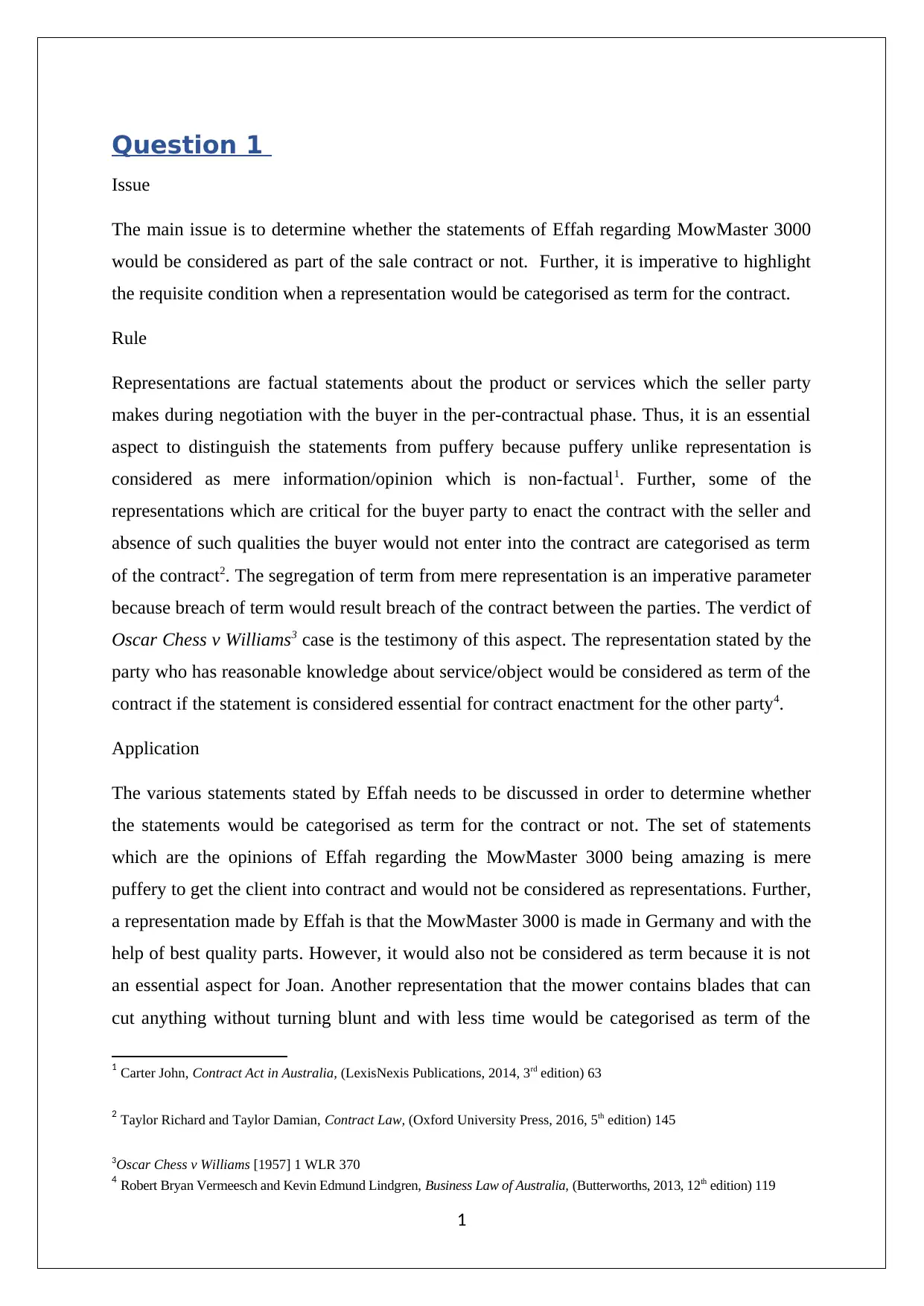
Question 1
Issue
The main issue is to determine whether the statements of Effah regarding MowMaster 3000
would be considered as part of the sale contract or not. Further, it is imperative to highlight
the requisite condition when a representation would be categorised as term for the contract.
Rule
Representations are factual statements about the product or services which the seller party
makes during negotiation with the buyer in the per-contractual phase. Thus, it is an essential
aspect to distinguish the statements from puffery because puffery unlike representation is
considered as mere information/opinion which is non-factual1. Further, some of the
representations which are critical for the buyer party to enact the contract with the seller and
absence of such qualities the buyer would not enter into the contract are categorised as term
of the contract2. The segregation of term from mere representation is an imperative parameter
because breach of term would result breach of the contract between the parties. The verdict of
Oscar Chess v Williams3 case is the testimony of this aspect. The representation stated by the
party who has reasonable knowledge about service/object would be considered as term of the
contract if the statement is considered essential for contract enactment for the other party4.
Application
The various statements stated by Effah needs to be discussed in order to determine whether
the statements would be categorised as term for the contract or not. The set of statements
which are the opinions of Effah regarding the MowMaster 3000 being amazing is mere
puffery to get the client into contract and would not be considered as representations. Further,
a representation made by Effah is that the MowMaster 3000 is made in Germany and with the
help of best quality parts. However, it would also not be considered as term because it is not
an essential aspect for Joan. Another representation that the mower contains blades that can
cut anything without turning blunt and with less time would be categorised as term of the
1 Carter John, Contract Act in Australia, (LexisNexis Publications, 2014, 3rd edition) 63
2 Taylor Richard and Taylor Damian, Contract Law, (Oxford University Press, 2016, 5th edition) 145
3Oscar Chess v Williams [1957] 1 WLR 370
4 Robert Bryan Vermeesch and Kevin Edmund Lindgren, Business Law of Australia, (Butterworths, 2013, 12th edition) 119
1
Issue
The main issue is to determine whether the statements of Effah regarding MowMaster 3000
would be considered as part of the sale contract or not. Further, it is imperative to highlight
the requisite condition when a representation would be categorised as term for the contract.
Rule
Representations are factual statements about the product or services which the seller party
makes during negotiation with the buyer in the per-contractual phase. Thus, it is an essential
aspect to distinguish the statements from puffery because puffery unlike representation is
considered as mere information/opinion which is non-factual1. Further, some of the
representations which are critical for the buyer party to enact the contract with the seller and
absence of such qualities the buyer would not enter into the contract are categorised as term
of the contract2. The segregation of term from mere representation is an imperative parameter
because breach of term would result breach of the contract between the parties. The verdict of
Oscar Chess v Williams3 case is the testimony of this aspect. The representation stated by the
party who has reasonable knowledge about service/object would be considered as term of the
contract if the statement is considered essential for contract enactment for the other party4.
Application
The various statements stated by Effah needs to be discussed in order to determine whether
the statements would be categorised as term for the contract or not. The set of statements
which are the opinions of Effah regarding the MowMaster 3000 being amazing is mere
puffery to get the client into contract and would not be considered as representations. Further,
a representation made by Effah is that the MowMaster 3000 is made in Germany and with the
help of best quality parts. However, it would also not be considered as term because it is not
an essential aspect for Joan. Another representation that the mower contains blades that can
cut anything without turning blunt and with less time would be categorised as term of the
1 Carter John, Contract Act in Australia, (LexisNexis Publications, 2014, 3rd edition) 63
2 Taylor Richard and Taylor Damian, Contract Law, (Oxford University Press, 2016, 5th edition) 145
3Oscar Chess v Williams [1957] 1 WLR 370
4 Robert Bryan Vermeesch and Kevin Edmund Lindgren, Business Law of Australia, (Butterworths, 2013, 12th edition) 119
1
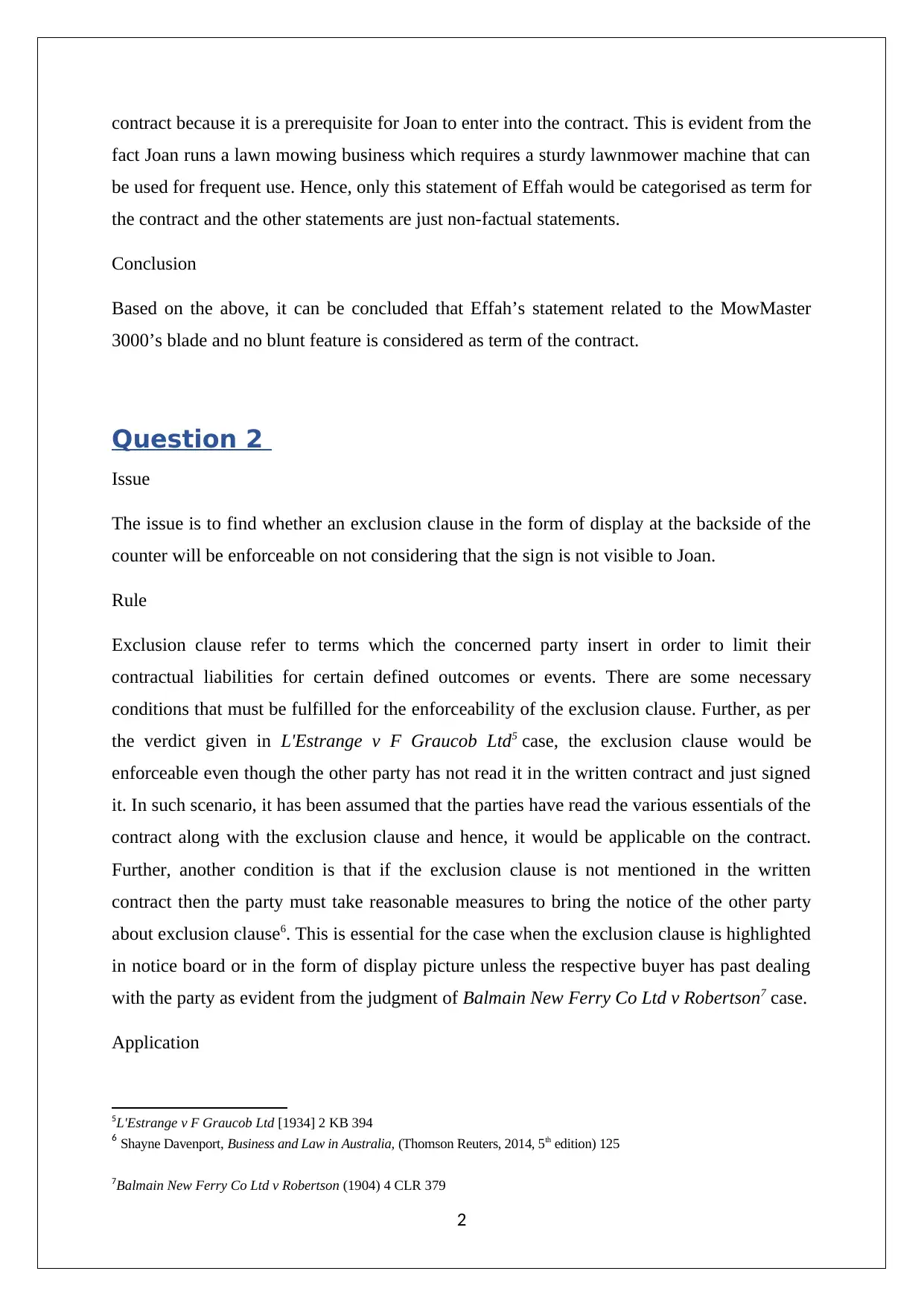
contract because it is a prerequisite for Joan to enter into the contract. This is evident from the
fact Joan runs a lawn mowing business which requires a sturdy lawnmower machine that can
be used for frequent use. Hence, only this statement of Effah would be categorised as term for
the contract and the other statements are just non-factual statements.
Conclusion
Based on the above, it can be concluded that Effah’s statement related to the MowMaster
3000’s blade and no blunt feature is considered as term of the contract.
Question 2
Issue
The issue is to find whether an exclusion clause in the form of display at the backside of the
counter will be enforceable on not considering that the sign is not visible to Joan.
Rule
Exclusion clause refer to terms which the concerned party insert in order to limit their
contractual liabilities for certain defined outcomes or events. There are some necessary
conditions that must be fulfilled for the enforceability of the exclusion clause. Further, as per
the verdict given in L'Estrange v F Graucob Ltd5 case, the exclusion clause would be
enforceable even though the other party has not read it in the written contract and just signed
it. In such scenario, it has been assumed that the parties have read the various essentials of the
contract along with the exclusion clause and hence, it would be applicable on the contract.
Further, another condition is that if the exclusion clause is not mentioned in the written
contract then the party must take reasonable measures to bring the notice of the other party
about exclusion clause6. This is essential for the case when the exclusion clause is highlighted
in notice board or in the form of display picture unless the respective buyer has past dealing
with the party as evident from the judgment of Balmain New Ferry Co Ltd v Robertson7 case.
Application
5L'Estrange v F Graucob Ltd [1934] 2 KB 394
6 Shayne Davenport, Business and Law in Australia, (Thomson Reuters, 2014, 5th edition) 125
7Balmain New Ferry Co Ltd v Robertson (1904) 4 CLR 379
2
fact Joan runs a lawn mowing business which requires a sturdy lawnmower machine that can
be used for frequent use. Hence, only this statement of Effah would be categorised as term for
the contract and the other statements are just non-factual statements.
Conclusion
Based on the above, it can be concluded that Effah’s statement related to the MowMaster
3000’s blade and no blunt feature is considered as term of the contract.
Question 2
Issue
The issue is to find whether an exclusion clause in the form of display at the backside of the
counter will be enforceable on not considering that the sign is not visible to Joan.
Rule
Exclusion clause refer to terms which the concerned party insert in order to limit their
contractual liabilities for certain defined outcomes or events. There are some necessary
conditions that must be fulfilled for the enforceability of the exclusion clause. Further, as per
the verdict given in L'Estrange v F Graucob Ltd5 case, the exclusion clause would be
enforceable even though the other party has not read it in the written contract and just signed
it. In such scenario, it has been assumed that the parties have read the various essentials of the
contract along with the exclusion clause and hence, it would be applicable on the contract.
Further, another condition is that if the exclusion clause is not mentioned in the written
contract then the party must take reasonable measures to bring the notice of the other party
about exclusion clause6. This is essential for the case when the exclusion clause is highlighted
in notice board or in the form of display picture unless the respective buyer has past dealing
with the party as evident from the judgment of Balmain New Ferry Co Ltd v Robertson7 case.
Application
5L'Estrange v F Graucob Ltd [1934] 2 KB 394
6 Shayne Davenport, Business and Law in Australia, (Thomson Reuters, 2014, 5th edition) 125
7Balmain New Ferry Co Ltd v Robertson (1904) 4 CLR 379
2
⊘ This is a preview!⊘
Do you want full access?
Subscribe today to unlock all pages.

Trusted by 1+ million students worldwide
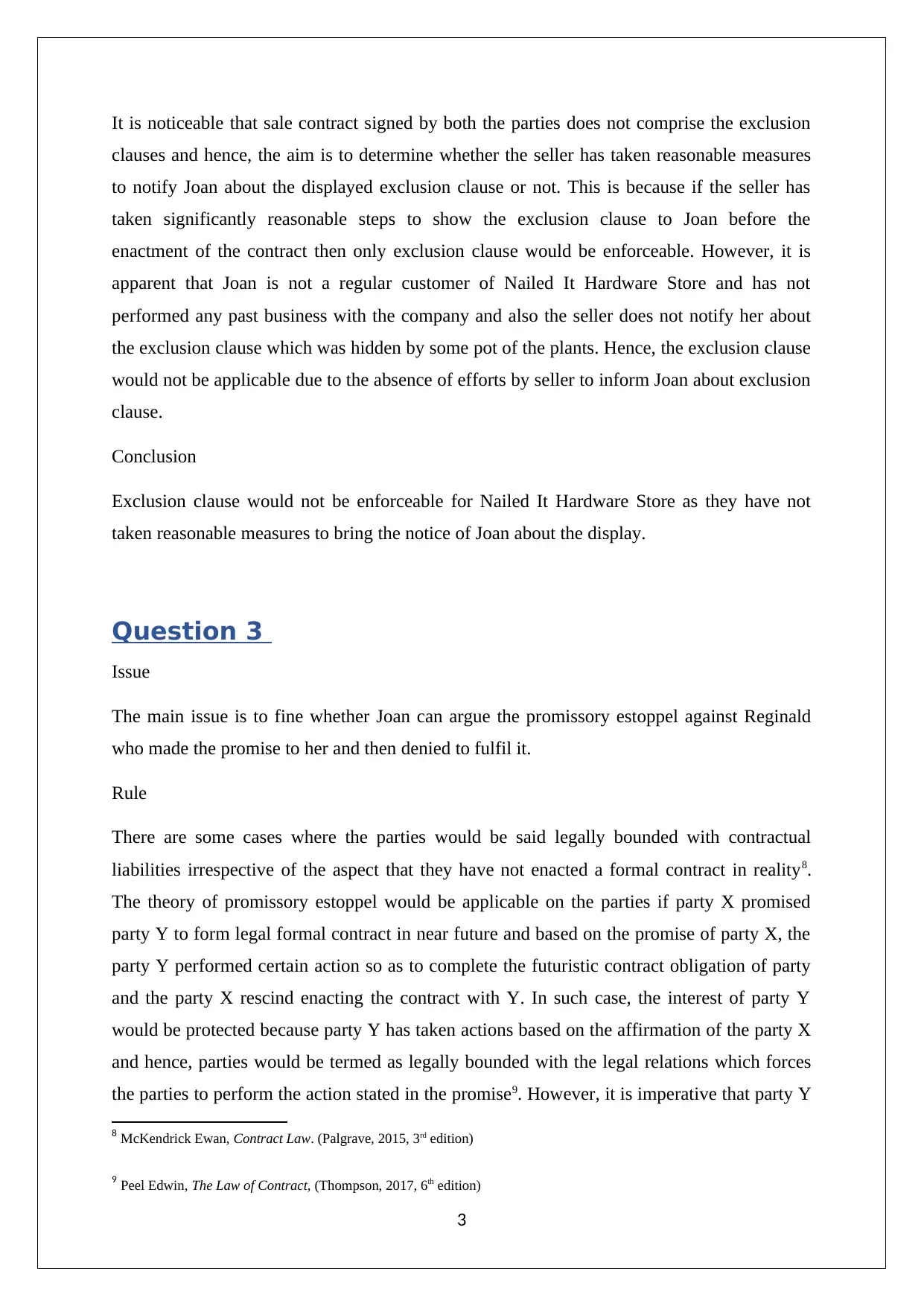
It is noticeable that sale contract signed by both the parties does not comprise the exclusion
clauses and hence, the aim is to determine whether the seller has taken reasonable measures
to notify Joan about the displayed exclusion clause or not. This is because if the seller has
taken significantly reasonable steps to show the exclusion clause to Joan before the
enactment of the contract then only exclusion clause would be enforceable. However, it is
apparent that Joan is not a regular customer of Nailed It Hardware Store and has not
performed any past business with the company and also the seller does not notify her about
the exclusion clause which was hidden by some pot of the plants. Hence, the exclusion clause
would not be applicable due to the absence of efforts by seller to inform Joan about exclusion
clause.
Conclusion
Exclusion clause would not be enforceable for Nailed It Hardware Store as they have not
taken reasonable measures to bring the notice of Joan about the display.
Question 3
Issue
The main issue is to fine whether Joan can argue the promissory estoppel against Reginald
who made the promise to her and then denied to fulfil it.
Rule
There are some cases where the parties would be said legally bounded with contractual
liabilities irrespective of the aspect that they have not enacted a formal contract in reality8.
The theory of promissory estoppel would be applicable on the parties if party X promised
party Y to form legal formal contract in near future and based on the promise of party X, the
party Y performed certain action so as to complete the futuristic contract obligation of party
and the party X rescind enacting the contract with Y. In such case, the interest of party Y
would be protected because party Y has taken actions based on the affirmation of the party X
and hence, parties would be termed as legally bounded with the legal relations which forces
the parties to perform the action stated in the promise9. However, it is imperative that party Y
8 McKendrick Ewan, Contract Law. (Palgrave, 2015, 3rd edition)
9 Peel Edwin, The Law of Contract, (Thompson, 2017, 6th edition)
3
clauses and hence, the aim is to determine whether the seller has taken reasonable measures
to notify Joan about the displayed exclusion clause or not. This is because if the seller has
taken significantly reasonable steps to show the exclusion clause to Joan before the
enactment of the contract then only exclusion clause would be enforceable. However, it is
apparent that Joan is not a regular customer of Nailed It Hardware Store and has not
performed any past business with the company and also the seller does not notify her about
the exclusion clause which was hidden by some pot of the plants. Hence, the exclusion clause
would not be applicable due to the absence of efforts by seller to inform Joan about exclusion
clause.
Conclusion
Exclusion clause would not be enforceable for Nailed It Hardware Store as they have not
taken reasonable measures to bring the notice of Joan about the display.
Question 3
Issue
The main issue is to fine whether Joan can argue the promissory estoppel against Reginald
who made the promise to her and then denied to fulfil it.
Rule
There are some cases where the parties would be said legally bounded with contractual
liabilities irrespective of the aspect that they have not enacted a formal contract in reality8.
The theory of promissory estoppel would be applicable on the parties if party X promised
party Y to form legal formal contract in near future and based on the promise of party X, the
party Y performed certain action so as to complete the futuristic contract obligation of party
and the party X rescind enacting the contract with Y. In such case, the interest of party Y
would be protected because party Y has taken actions based on the affirmation of the party X
and hence, parties would be termed as legally bounded with the legal relations which forces
the parties to perform the action stated in the promise9. However, it is imperative that party Y
8 McKendrick Ewan, Contract Law. (Palgrave, 2015, 3rd edition)
9 Peel Edwin, The Law of Contract, (Thompson, 2017, 6th edition)
3
Paraphrase This Document
Need a fresh take? Get an instant paraphrase of this document with our AI Paraphraser
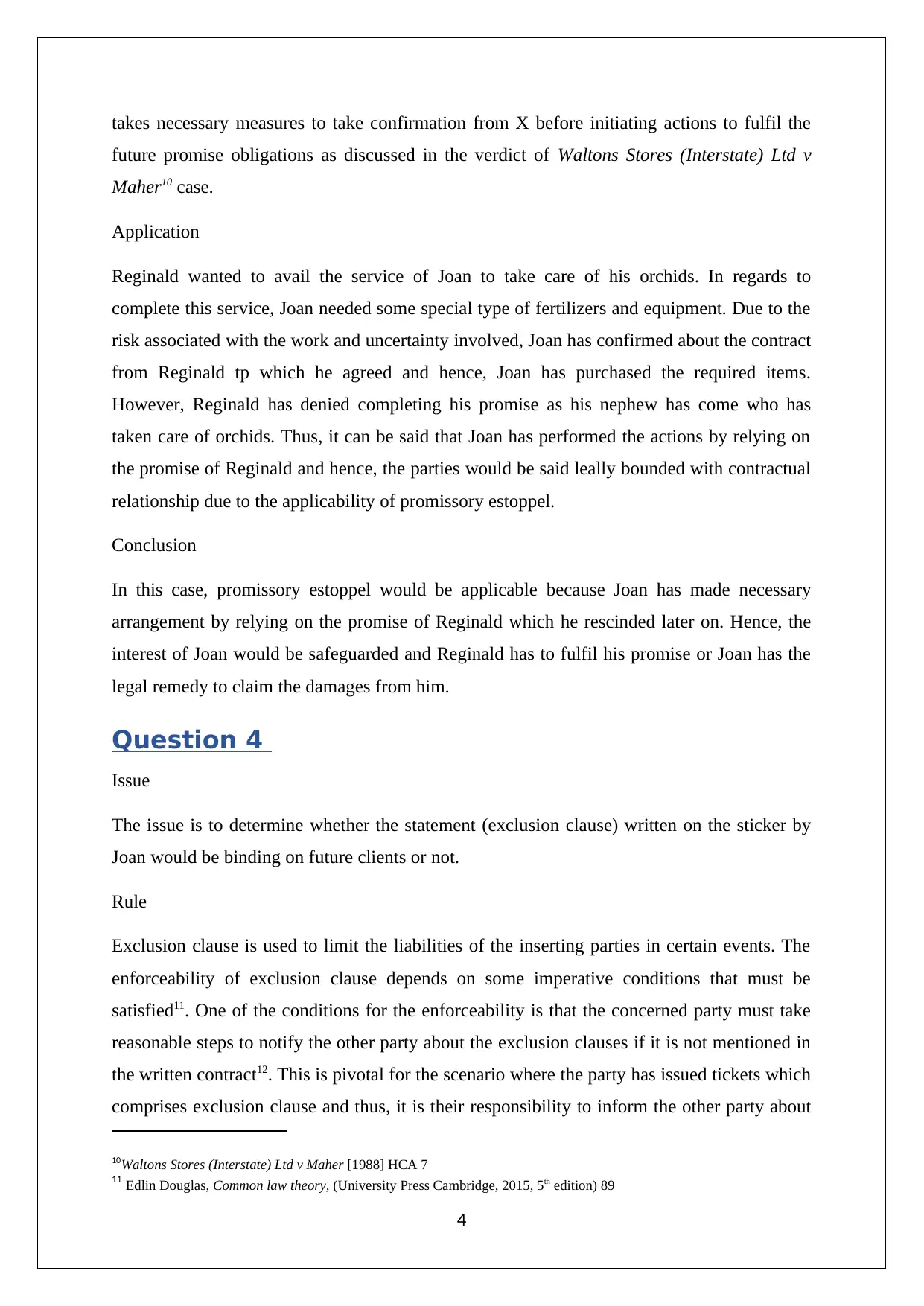
takes necessary measures to take confirmation from X before initiating actions to fulfil the
future promise obligations as discussed in the verdict of Waltons Stores (Interstate) Ltd v
Maher10 case.
Application
Reginald wanted to avail the service of Joan to take care of his orchids. In regards to
complete this service, Joan needed some special type of fertilizers and equipment. Due to the
risk associated with the work and uncertainty involved, Joan has confirmed about the contract
from Reginald tp which he agreed and hence, Joan has purchased the required items.
However, Reginald has denied completing his promise as his nephew has come who has
taken care of orchids. Thus, it can be said that Joan has performed the actions by relying on
the promise of Reginald and hence, the parties would be said leally bounded with contractual
relationship due to the applicability of promissory estoppel.
Conclusion
In this case, promissory estoppel would be applicable because Joan has made necessary
arrangement by relying on the promise of Reginald which he rescinded later on. Hence, the
interest of Joan would be safeguarded and Reginald has to fulfil his promise or Joan has the
legal remedy to claim the damages from him.
Question 4
Issue
The issue is to determine whether the statement (exclusion clause) written on the sticker by
Joan would be binding on future clients or not.
Rule
Exclusion clause is used to limit the liabilities of the inserting parties in certain events. The
enforceability of exclusion clause depends on some imperative conditions that must be
satisfied11. One of the conditions for the enforceability is that the concerned party must take
reasonable steps to notify the other party about the exclusion clauses if it is not mentioned in
the written contract12. This is pivotal for the scenario where the party has issued tickets which
comprises exclusion clause and thus, it is their responsibility to inform the other party about
10Waltons Stores (Interstate) Ltd v Maher [1988] HCA 7
11 Edlin Douglas, Common law theory, (University Press Cambridge, 2015, 5th edition) 89
4
future promise obligations as discussed in the verdict of Waltons Stores (Interstate) Ltd v
Maher10 case.
Application
Reginald wanted to avail the service of Joan to take care of his orchids. In regards to
complete this service, Joan needed some special type of fertilizers and equipment. Due to the
risk associated with the work and uncertainty involved, Joan has confirmed about the contract
from Reginald tp which he agreed and hence, Joan has purchased the required items.
However, Reginald has denied completing his promise as his nephew has come who has
taken care of orchids. Thus, it can be said that Joan has performed the actions by relying on
the promise of Reginald and hence, the parties would be said leally bounded with contractual
relationship due to the applicability of promissory estoppel.
Conclusion
In this case, promissory estoppel would be applicable because Joan has made necessary
arrangement by relying on the promise of Reginald which he rescinded later on. Hence, the
interest of Joan would be safeguarded and Reginald has to fulfil his promise or Joan has the
legal remedy to claim the damages from him.
Question 4
Issue
The issue is to determine whether the statement (exclusion clause) written on the sticker by
Joan would be binding on future clients or not.
Rule
Exclusion clause is used to limit the liabilities of the inserting parties in certain events. The
enforceability of exclusion clause depends on some imperative conditions that must be
satisfied11. One of the conditions for the enforceability is that the concerned party must take
reasonable steps to notify the other party about the exclusion clauses if it is not mentioned in
the written contract12. This is pivotal for the scenario where the party has issued tickets which
comprises exclusion clause and thus, it is their responsibility to inform the other party about
10Waltons Stores (Interstate) Ltd v Maher [1988] HCA 7
11 Edlin Douglas, Common law theory, (University Press Cambridge, 2015, 5th edition) 89
4
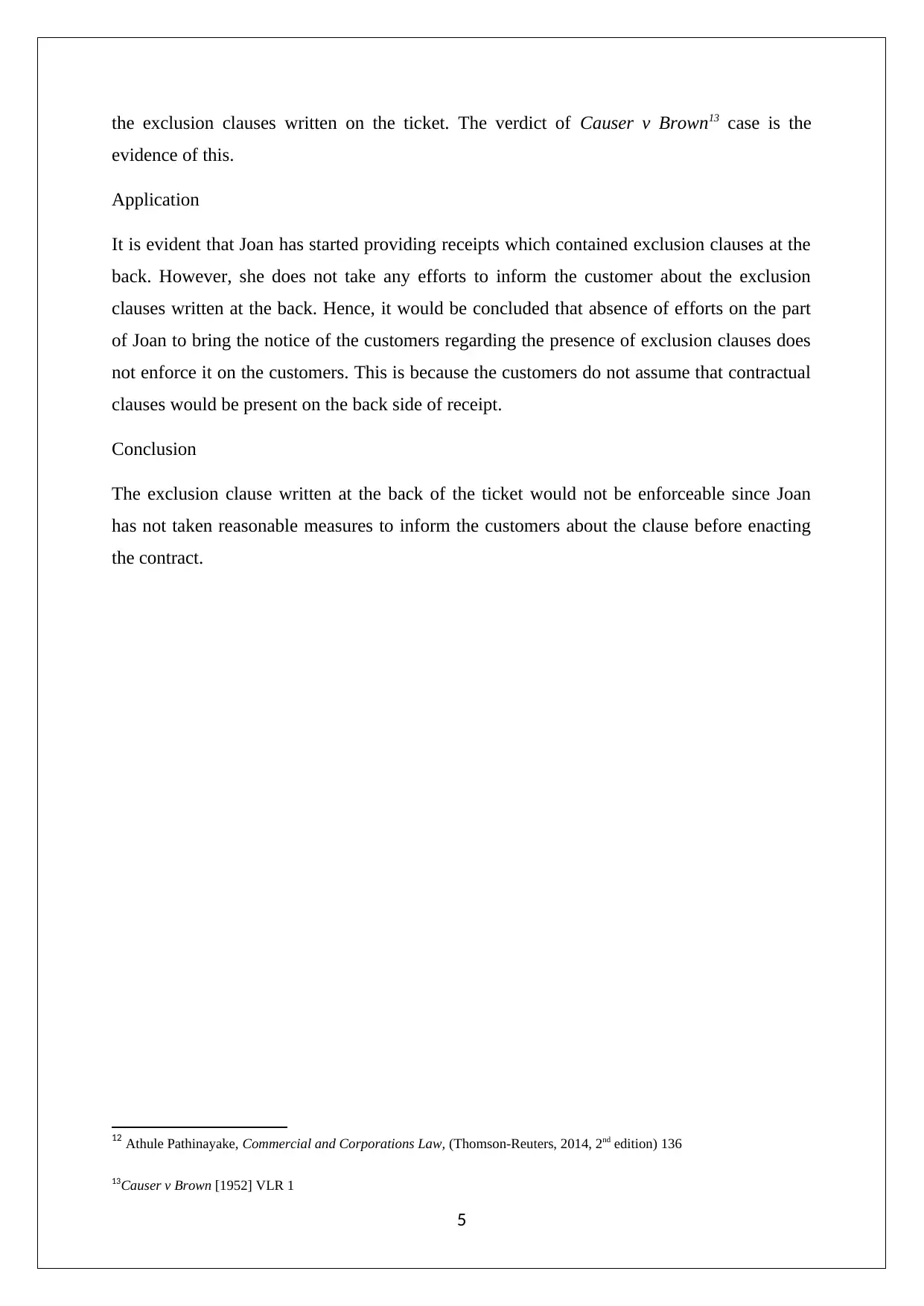
the exclusion clauses written on the ticket. The verdict of Causer v Brown13 case is the
evidence of this.
Application
It is evident that Joan has started providing receipts which contained exclusion clauses at the
back. However, she does not take any efforts to inform the customer about the exclusion
clauses written at the back. Hence, it would be concluded that absence of efforts on the part
of Joan to bring the notice of the customers regarding the presence of exclusion clauses does
not enforce it on the customers. This is because the customers do not assume that contractual
clauses would be present on the back side of receipt.
Conclusion
The exclusion clause written at the back of the ticket would not be enforceable since Joan
has not taken reasonable measures to inform the customers about the clause before enacting
the contract.
12 Athule Pathinayake, Commercial and Corporations Law, (Thomson-Reuters, 2014, 2nd edition) 136
13Causer v Brown [1952] VLR 1
5
evidence of this.
Application
It is evident that Joan has started providing receipts which contained exclusion clauses at the
back. However, she does not take any efforts to inform the customer about the exclusion
clauses written at the back. Hence, it would be concluded that absence of efforts on the part
of Joan to bring the notice of the customers regarding the presence of exclusion clauses does
not enforce it on the customers. This is because the customers do not assume that contractual
clauses would be present on the back side of receipt.
Conclusion
The exclusion clause written at the back of the ticket would not be enforceable since Joan
has not taken reasonable measures to inform the customers about the clause before enacting
the contract.
12 Athule Pathinayake, Commercial and Corporations Law, (Thomson-Reuters, 2014, 2nd edition) 136
13Causer v Brown [1952] VLR 1
5
⊘ This is a preview!⊘
Do you want full access?
Subscribe today to unlock all pages.

Trusted by 1+ million students worldwide
1 out of 6
Related Documents
Your All-in-One AI-Powered Toolkit for Academic Success.
+13062052269
info@desklib.com
Available 24*7 on WhatsApp / Email
![[object Object]](/_next/static/media/star-bottom.7253800d.svg)
Unlock your academic potential
Copyright © 2020–2025 A2Z Services. All Rights Reserved. Developed and managed by ZUCOL.





